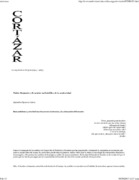| dc.contributor.author | Figueroa Suárez, Alejandra | spa |
| dc.date.accessioned | 2020-10-27T00:09:10Z | |
| dc.date.available | 2020-10-27T00:09:10Z | |
| dc.date.issued | 2011 | |
| dc.identifier.issn | 2145-7190 | |
| dc.identifier.uri | http://hdl.handle.net/20.500.12749/8680 | |
| dc.description.abstract | Como el caminante de los cuadros de Caspar David Friedrich, el hombre que ha conquistado y dominado la naturaleza se encuentra solo
ante un mundo lleno de bruma. La naturaleza pierde toda su potencia mítica -vital- ante la ciencia y tecnología.En este mundo, desolado y
desarraigado, sólo quedan las sombras de lo mágico y mítico de épocas anteriores. En la cima del mundo el hombre se da cuenta del que el
precio que ha tenido que pagar por su conocimiento del mundo ha sido el de su más profunda desesperación. | spa |
| dc.format.mimetype | application/pdf | spa |
| dc.language.iso | spa | spa |
| dc.publisher | Universidad Autónoma de Bucaramanga UNAB | |
| dc.relation | https://revistas.unab.edu.co/index.php/laterceraorilla/article/view/3052/2545 | |
| dc.relation.uri | https://revistas.unab.edu.co/index.php/laterceraorilla/article/view/3052 | |
| dc.rights.uri | http://creativecommons.org/licenses/by-nc-nd/2.5/co/ | |
| dc.source | La Tercera Orilla; Núm. 7 (2011) | |
| dc.subject | Ciencias sociales | |
| dc.subject | Publicaciones seriadas | |
| dc.subject | Investigaciones | |
| dc.subject | Arte y cultura | |
| dc.subject | Literatura | |
| dc.title | Walter Benjamín y el carácter mefistofélico de la modernidad | spa |
| dc.title.translated | Walter Benjamin and the Mephistophelian character of modernity | eng |
| dc.type.driver | info:eu-repo/semantics/article | |
| dc.type.local | Artículo | spa |
| dc.type.coar | http://purl.org/coar/resource_type/c_7a1f | |
| dc.subject.keywords | Social sciences | eng |
| dc.subject.keywords | Serials | eng |
| dc.subject.keywords | Investigations | eng |
| dc.subject.keywords | Art and culture | eng |
| dc.subject.keywords | Literature | eng |
| dc.identifier.instname | instname:Universidad Autónoma de Bucaramanga UNAB | spa |
| dc.type.hasversion | Info:eu-repo/semantics/publishedVersion | |
| dc.type.hasversion | info:eu-repo/semantics/acceptedVersion | spa |
| dc.rights.accessrights | info:eu-repo/semantics/openAccess | spa |
| dc.relation.references | AGAMBEN, Giorgio. (2005). Profanaciones. Adriana Hidalgo Editora. Buenos Aires. Argentina. BAUDELAIRE, Charles. P.
(1984). Las flores del mal. Alianza Editores. Madrid. España. | spa |
| dc.relation.references | BENJAMIN. Walter. (2000). La dialéctica en suspenso: Fragmentos sobre historia. Libros de la invención y la herencia. Ediciones
Arcis. Santiago de Chile. | |
| dc.relation.references | BENJAMIN. Walter. (1991). Para una crítica de la violencia y otros ensayos. Editorial. Taurus Humanidades. Madrid. España. | |
| dc.relation.references | FOSTER. Ricardo. (2003). Walter Benjamin y el problema del mal. Ed. Altamira. Buenos Aires, Argentina. | |
| dc.relation.references | GIDDENS. Anthony. (1997). Modernidad e identidad del Yo. Capitulo. II. El yo: Seguridad ontológica y angustia existencial. Barcelona
Editores. | |
| dc.relation.references | HORKHEIMER. Max & ADORNO, Theodor. (2001). Dialéctica de la Ilustración. Editorial Trotta. Barcelona. España. | |
| dc.relation.references | HÖLDERLIN. Friedrich. (2004). Poemas Textos bilingües. Poesía Hiperión, 470. Editorial. Hiperión. Madrid España. | |
| dc.relation.references | LÖWY. Michael. (2003). Walter Benjamin: Aviso de incendio. Fondo de Cultura Económica. México. | |
| dc.relation.references | MARX, Karl., & Engels, Friedrich. (1985). El manifiesto comunista: Once tesis sobre Feuerbach. Editorial Alhambra. Madrid.
España. | |
| dc.relation.references | OTTO. Rudolf. (1996). Lo Santo. Lo racional e irracional en la idea de Dios. Alianza Editorial. Cuarta Impresión. Madrid. España. | |
| dc.relation.references | Reyes Mate. (2006). Medianoche en la historia: comentarios a las tesis de Walter Benjamin "Sobre el concepto de historia". Madrid:
Trotta. Pág.108 | |
| dc.relation.references | SCHILLER, Friedrich. (1998). Poesía filosófica. Hiperión, Madrid. | |
| dc.relation.references | TRAVERSO, Enzo. (2003). The origins of Nazi violence. New York New Press. | |
| dc.relation.references | VILLACAÑAS. B. Jose, Luis. (2008). Poder y Conflicto: Ensayos sobre Carl Schmitt. Biblioteca Saavedra Fajardo. Madrid. España. | |
| dc.subject.lemb | Ciencias sociales | spa |
| dc.subject.lemb | Publicaciones seriadas | spa |
| dc.subject.lemb | Arte y cultura | spa |
| dc.subject.lemb | Investigación | spa |
| dc.subject.lemb | Literatura | spa |
| dc.identifier.repourl | repourl:https://repository.unab.edu.co | |
| dc.description.abstractenglish | Like the wanderer in Caspar David Friedrich's paintings, the man who has conquered and mastered nature finds himself alone.
before a world full of mist. Nature loses all its mythical power -vital- before science and technology. In this world, desolate and
uprooted, only the shadows of the magical and mythical of earlier times remain. At the top of the world the man realizes that the
The price he has had to pay for his knowledge of the world has been that of his deepest despair. | eng |
| dc.type.redcol | http://purl.org/redcol/resource_type/ART | |
| dc.rights.creativecommons | Atribución-NoComercial-SinDerivadas 2.5 Colombia | * |


